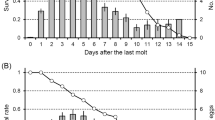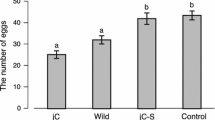Abstract
Two genetically incompatible Panonychus mites (Panonychus citri and Panonychus mori) geographically segregate their distributions in Japan. They occasionally co-exist on deciduous fruit trees at the intermediate latitudes, but their occurrences are unstable and P. mori is often excluded. Interspecific matings between the two species interfere with a subsequent effective intraspecific mating, to a greater extent for P. mori than for P. citri. Panonychus mori males show a strong preference for conspecific females, whereas P. citri males do not show any mating preference. This suggests that under the co-existence of the two species the deleterious effect through reproductive interference is more intense for P. mori than for P. citri. On peach trees where the two species co-exist with various density ratios, the proportion of ineffective females (females that did not produce any female offspring) was higher in P. mori than in P. citri and the proportion increased with increasing density of the other species relative to that of its own species. A simple differential equation model incorporating the above reproductive interference demonstrated that the stable co-existence of the two species is unlikely and that P. citri will have a much higher chance of excluding P. mori, due to a greater reproductive interference effect and higher reproductive rate than the latter. However, the outcome of competition depends on the initial density ratios, which will be influenced by various stochastic events, thereby reducing the probability of one-sided exclusion over a wider area.
Similar content being viewed by others
REFERENCES
Boudreaux, H. B. 1963. Biological aspects of some phytophagous mites. Ann. Rev. Entomol. 8: 137–154.
Denno, R. F., McClure, M. S. and Ott, J. R. 1995. Interspecific interactions in phytophagous insects: competition reexamined and resurrected. Ann. Rev. Entomol. 40: 297–331.
Ehara, S. and Gotoh, T. 1992. Descriptions of two Panonychus spider mites from Japan, with a key to species of the genus in the world (Acari: Tetranychidae). Appl. Entomol. Zool. 27: 107–115.
Fujimoto, H., Hiramatsu, T. and Takafuji, A. 1996. Reproductive interference between Panonychus mori Yokoyama and P. citri (McGregor) (Acari: Tetranychidae) in peach orchards. Appl. Entomol. Zool. 31: 59–65.
Gotoh, T. and Noguchi, K. 1990. Developmental success and reproductive incompatibility among populations of the European red mite, Panonychus ulmi (Acari: Tetranychidae). Exp. Appl. Acarol. 10: 157–165.
Helle, W. and Van de Bund, C. F. 1962. Crossbreeding experiments with some species of Tetranychus urticae group. Entomol. Exp. Appl. 5: 159–165.
Kunimoto, N., Shinkaji, N. and Amano, H. 1991. [Reproductive isolation between different types of Panonychus citri (McGregor) and P. ulmi (Koch) (Acari: Tetranychidae).] Jpn. J. Appl. Entomol. Zool. 35: 103–108 (in Japanese with English summary).
Kunimoto, N., Shinkaji, N. and Amano, H. 1993. [Spread of the citrus red mite, Panonychus citri (McGregor) (Acari: Tetranychidae), from Ilex crenata Thunb, to a Japanese-pear orchard.] Jpn. J. Appl. Entomol. Zool. 37: 69–73 (in Japanese with English summary).
Kuno, E. 1992. Competitive exclusion through reproductive interference. Res. Popul. Ecol. 34: 275–284.
Morimoto, N. and Takafuji, A. 1983. [Comparison of diapause attributes and host preference among three populations of the citrus red mite, Panonychus citri (McGregor) occurring in the southern part of Okayama Prefecture, Japan.] Jpn J. Appl. Entomol. Zool. 27: 224–228 (in Japanese with English summary).
Osakabe, Mh. 1993. Divergence of the northern and southwestern populations of Panonychus mori Yokoyama (Acari: Tetranychidae) in Japan in host range and reproductive compatibility. Appl. Entmol. Zool. 28: 189–197.
Ozawa, A. and Takafuji, A. 1987. [Inter-specific crosses between Tetranychus urticae Koch and Tetranychus kanzawai Kishida.] Jpn J. Appl. Entomol. Zool. 28: 189–197 (in Japanese with English summary).
Shinkaji, N. 1961. [Geographical distribution of the citrus red mite, Panonychus citri (McGregor), living on major fruit trees in Japan.] Bull. Horticult. Stn Nat. Tokai-Kinki Agricult. Exp. Stn 6: 49–63 (in Japanese with English summary).
Shinkaji, N. 1979. Geographical distribution of the citrus red mite, Panonychus citri (McGregor) and European red mite, Panonychus ulmi (Koch) in Japan. Recent Adv. Acarol. 1: 81–87.
Shinkaji, N., Santa, T., Amano, H., Fukuda, H. and Fujiie, A. 1986. [Geographical distribution of the diapause and nondiapause citrus red mite in Chiba Prefecture.] Proc. Kanto-Tosan Plant Prot. Soc. 33: 219–220 (in Japanese).
Smith, J. W. 1975. Spider mites: population suppression by interspecific hybridization. Environ. Entomol. 4: 588–590.
Strong, D. R., Lawton, J. H. and Southwood, T. R. E. 1992. Insects on Plants, Community Patterns and Mechanisms. Blackwell, London.
Sun, X. G., Shinkaji, N. and Amano, H. 1988. [Seasonal development of the diapausing and non-diapausing populations of the citrus red mite, Panonychus citri (McGregor) (Acarina: Tetranychidae).] Jpn J. Appl. Entomol. Zool. 32: 260–265 (in Japanese with English summary).
Takafuji, A. 1986. Effectiveness of second mating for two incompatible types of the citrus red mite, Panonychus citri (McGregor). Res. Popul. Ecol. 28: 91–101.
Takafuji, A. 1988. Mating between diapausing and nondiapausing strains of the citrus red mite, Panonychus citri (McGregor). Mem. Entomol. Soc. Can. 146: 181–189.
Takafuji, A. and Fujimoto, H. 1985. Reproductive compatibility between populations of the citrus red mite, Panonychus citri (McGregor) (Acarina: Tetranychidae). Res. Popul. Ecol. 27: 361–371.
Takafuji, A. and Fujimoto, H. 1986. Winter survival of the non-diapausing populations of the citrus red mite, Panonychus citri (McGregor) on pear and citrus. Appl. Entomol. Zool. 21: 467–473.
Takafuji, A. and Morimoto, N. 1983. Diapause attributes and seasonal occurrences of two populations of the citrus red mite, Panonychus citri (McGregor) on pear (Acarina: Tetranychidae). Appl. Entomol. Zool. 18: 525–532.
Author information
Authors and Affiliations
Rights and permissions
About this article
Cite this article
Takafuji, A., Kuno, E. & Fujimoto, H. Reproductive interference and its consequences for the competitive interactions between two closely related Panonychus spider mites. Exp Appl Acarol 21, 379–391 (1997). https://doi.org/10.1023/A:1018423711166
Issue Date:
DOI: https://doi.org/10.1023/A:1018423711166




